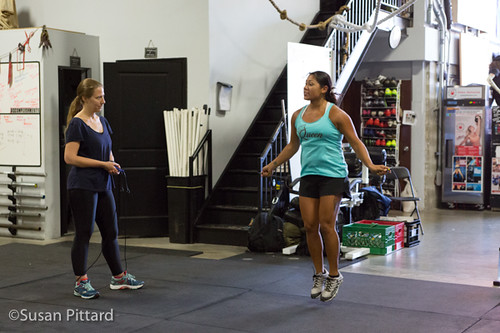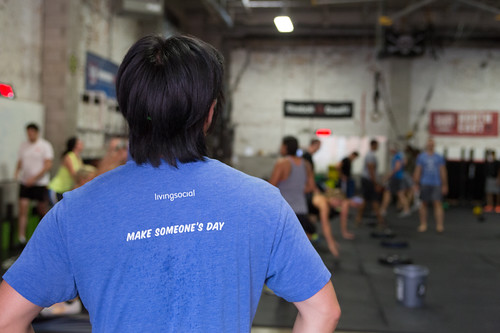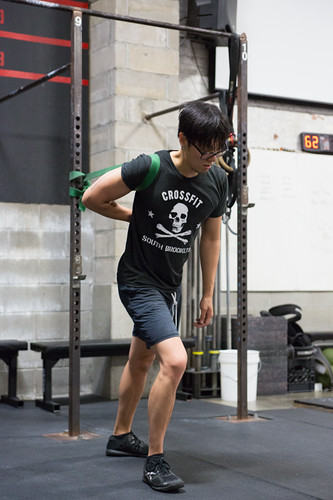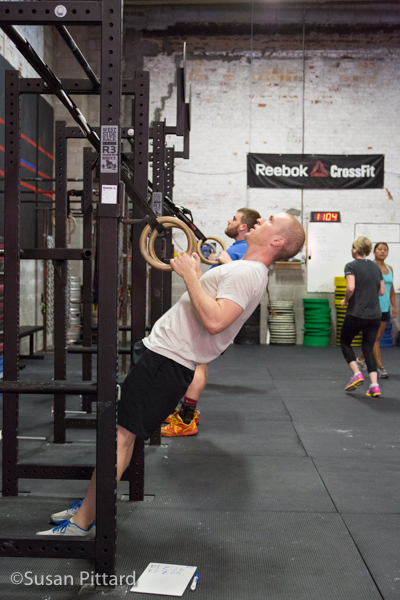A CrossFit Coach’s Guide to Working with New or Troubled Movers
 Tuesday, September 2, 2014 at 12:00AM
Tuesday, September 2, 2014 at 12:00AM 
A basic reality of any and all group exercise programs is that people are going to be working semi-autonomously for large portions of class. Often times, you'll come across individuals who need way more help than the average person—the kind of people that make you think, "Oh boy, can you do the exact opposite of all that??" If you plan on doing any group coaching, whether CrossFit or otherwise, you're going to deal with these people on a daily basis. And you, as the empathetic coach, may not be quite sure how to deal with troubled movers while also not ignoring the rest of the class. You need to learn some skills that enable you to triage these people so that they can remain safe and informed about how to handle themselves while you’re not there. In today's article, we're going to share some strategies and examples of how to work with people who need more than basic cues and corrections.
Working with difficult movers is not an intuitive process for new coaches, especially if the coach never significantly struggled picking up new physical skills. Understanding what is and is not appropriate for people takes some time to learn, while effectively coaching these people and providing appropriate substitutions is an even more nuanced process. CFSBK’s leveled programming addresses the constant need for substitutions and is designed to work on behalf of our coaching staff, so that the majority of their time isn’t spent dealing with the people for whom certain movements are inappropriate. Once your programming is established, to effectively help people, you'll first need to 1) assess why they're struggling; 2) provide modifications, and then 3) give specific programming advice for continuing to work while you're not watching. As professionals, it's our job to do our best to make their participation in the group environment safe and effective while providing them with the resources to work intelligently on their own.
(In a previous article, we talked about more extreme cases that may not be appropriate for group classes in general. If you didn't see it, please check it out after this article).
 1) Assessing Why People are Struggling
1) Assessing Why People are Struggling
There are three main reasons why someone might be struggling with an exercise: they are brand new, missing range-of-motion/have orthopedic restrictions, or are a disorganized mover. Obviously humans don’t fall neatly into categories, and people often struggle for more than one reason. Understanding why someone is struggling will help you, as a coach, to make a more informed decision about how to modify their workout (which we’ll discuss in more detail after explaining the categories).
Brand new: This person is brand new to CrossFit and doesn’t have significant exposure to even the most basic exercises employed in the program beyond Foundations. For them, the issue may not be an ability to perform advanced movements, but whether more fundamental movement patterns have been developed. Even someone with excellent mobility and good body awareness isn't going to be ready for "Isabel" a few days out of Foundations. Your approach to working with this person would be related to motor development and require using a less technically demanding movement, breaking an exercise down into smaller segments, or employing tempo work to ingrain good positions between movements.
Missing range-of-motion/orthopedic restrictions: This person is missing range-of-motion, due to either a profound lack of mobility, or a past or current injury. If the person can’t perform the movement, your approach would be to find a substitute that provides a similar stimulus but doesn’t require the person to attempt an unsafe or unavailable range-of-motion. Consider substituting for a movement they can perform, or in less extreme cases, simply scale the weight to a load they can work with safely. Often, you’ll prescribe permanent substitutions for movements, so, for example, you’d let the person know that whenever overhead squats come up, they’ll sub front squats.
Open chain/disorganized mover: This person isn’t necessarily new, nor do they have significant range-of-motion limitations, but they consistently struggle with more complex movements and perhaps could get a better training effect by performing a less technically demanding movement. The key is to allow them to train with intensity while remaining safe. Your approach might also be to substitute the movement, break it down into segments, or to use tempos.
 2. Provide Modifications
2. Provide Modifications
Once you identify the limiting factors for a particular person, you need to modify their workout accordingly.
Movement Substitutions and Tempos
If you're teaching CrossFit, a good place to begin understanding movement substitutions is Kelly Starrett's Movement Hierarchy outlined in chapter five of "Becoming A Supple Leopard." He describes three different categories of commonly-used movements in CrossFit, ranging from basic exercises that are more stable and require less coordination, to more complex motor patterns such as snatches and muscle-ups. This chapter provides some insight as to why you might substitute a particular movement. Of course, only time and experience will give you the full set of tools necessary to assess a situation and provide appropriate modifications.
Assigning tempos is another easy way to slow a person down and ingrain better movement patterns, whether in a WOD or specific exercise. For example, someone who is struggling with power cleans might be instructed to hold the start position, the racked position in a 1/4 squat, and finally their finished position at full extension for three seconds. This modification allows them to develop a better understanding of how to properly set up and link together this relatively complex movement. A tempo prescription is especially useful for people during timed workouts because it takes their mind off the clock on the wall and back into executing the movements with intention.
3. Providing Specific Programming Guidance
Once you've cued out and modified your athlete, you then need to give that person specific guidance about how to continue working while you're not standing next to him or her. As a coach, you want to minimize the variables that require you to turn around every five minutes to keep an eye on the troubled mover/s in class. The lifting component of a class might be to work up to a heavy triple on the deadlift, but perhaps the person struggling to keep their back set needs to do two more warm-up sets at this weight, then three sets of five reps with an added 15 pounds so they can focus on positions without interference from the load. Remember that movement doesn’t happen in a vacuum, and the key is to give people specific programming guidance as opposed to only general movement advice.
 Case Studies
Case Studies
The Brand New CrossFitter
"Jessie" is two weeks out from Foundations and has been going to group class three days per week. She is generally a good mover but besides the last few weeks of CrossFit, she has never done any sort of actual weightlifting. She shows up on a day the gym programmed heavy split jerks taken out of the rack. During the group movement review, you can tell she's a little confused, not good at bracing, and somewhat inconsistent with her footwork.
Triage
When someone is new to the gym, I'll often make technical substitutions not because the person can't eventually perform the movement well—but because a more fundamental movement pattern hasn't yet been established. In Jessie’s case, I would tell her to perform sets of three push presses, focusing on a tight brace and holding the top of each press for a two-count, working on maintaining active shoulders and a neutral spine. She should add weight after each set until she finds a load that feels heavy enough that she is working but light enough that her form remains perfect.
Instead of trying to wedge her into the same hole as the rest of class, Jessie can train more effectively by working a basic push press (or press, even), and I can walk away to help others and not be worried about what all of her reps are going to look like. Additionally, a push press can be taught or reviewed in seconds, which puts less of a demand on the coach to review a more advanced skill.
When Jessie gets more comfortable transferring force into a barbell overhead, she can begin more dedicated work on the split jerk. Usually new people are extremely relieved to have something simpler to work on. The same kind of substitution could be made on a workout such as "Grace" where the new athlete will perform 30 reps of Deadlift + Hang Power Clean + Push Press, instead of attempting the real benchmark for time.
 The Not-So-Supple Leopard
The Not-So-Supple Leopard
"Martin" has ravaged his thoracic spine and shoulders by way of 30+ years spent sitting in front of a variety of screens. He's been a member for a while and knows basic mobilizations for his upper body, but still has a long way to go if he'll ever even be able to hold a fully mature position overhead. He comes to a class where the gym is working handstand kick-ups to partners. Because a somewhat complete range-of-motion is required to hold yourself upside down, no amount of cueing is going to stop his elbows from bending and head crashing forward each time he kicks up. The last thing you want is to have this poor guy fall on his face or kick his partner by mistake, but as a coach, you have 12 other people that are paying for your attention.
Triage
Instead of telling him not to bend his elbows and to "keep working on it," it would be more prudent to quickly show him a wall walk to about 45 degrees where he is less challenged but still is working on shoulder stability and inversion strength like the rest of the group. Tell him to perform seven sets of 10-second holds resting about 45-60 seconds between attempts. This teaches Martin a modification that is appropriate for him and requires less of your attention—he knows exactly what he'll be doing when you walk away from him. You could also tell him to do one of his mobilizations between each attempt.
The Injured Athlete
"Robert" has had a herniated disc between C6/7 for the last year and going into any kind of cervical extension puts him at serious risk for re-aggravating the injury. He shows up on a day when the workout includes wall balls, kipping pull-ups, and sit-ups.
 Triage
Triage
Situations where a member has already experienced a more profound injury—either new or old—and is trying to work around it are always highly specific situations and require an on-going dialogue between the athlete and coach. Again, experience working with similar issues and a little understanding of orthopedic pathology go a long way in making appropriate recommendations.
In situations like Robert’s, I'll usually provide a list of common substitutions ahead of time so that the person becomes better at self-modifying their participation at the gym, enabling them to work in a group setting more easily. Everyone is a unique little snowflake, but orthopedic issues make you even more unique. Once an appropriate substitution guide is created, the athlete and coaches need to work together indefinitely, checking in on how someone's feeling and riding them a little harder to move as well as they can every day.
For the prescribed triplet of wall balls, kipping pull-ups, and sit-ups, we'd switch it to dumbbell front squats, ring rows, and plank holds. These substitutions are less likely to have Robert creeping into a situation where cervical extension is probable, and they allow him to get a good training session without aggravating his existing condition or requiring a coach ride him constantly to keep his chin down.
Conclusion
The bottom line of all of the above information is that as a coach, you have to learn to do what feels like a million things at once. We asked one of CFSBK’s new coaches, Whitney, about her experience with beginning to coach CrossFit. She had been a yoga instructor for years, but says coaching CrossFit required new ways of seeing the proverbial forest for the trees. “Having tools to deal with especially troubled movers enables you to manage an entire class in a way that distributes your attention amongst everyone,” Whitney said. “Part of good coaching is not just saying the same things over and over, but really seeing what’s happening in your class, and responding to the people in it.”

Reader Comments (3)
This is really helpful. Thanks for writing.
Thanks for sharing a great article, i like this valuable packers and movers post content.
Thanks for reading and commenting, guys!